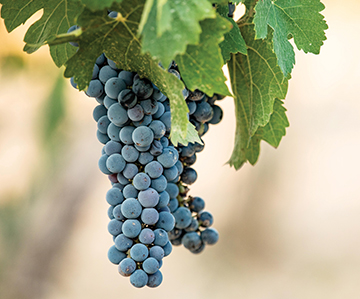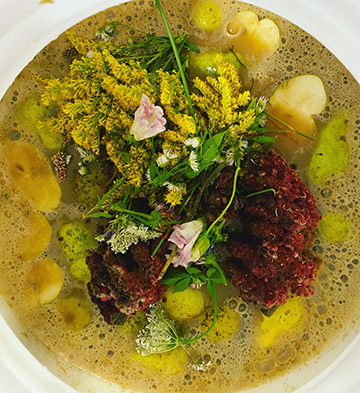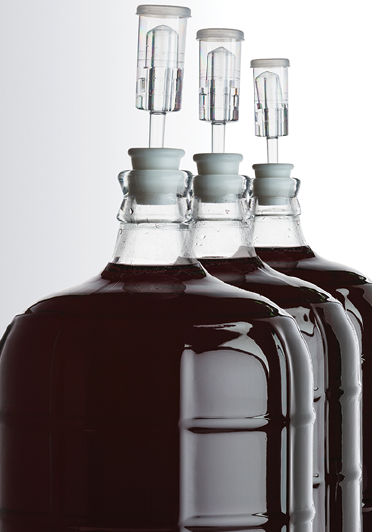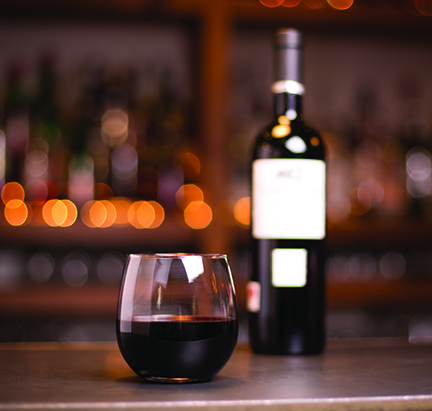
Every Spring, as buds begin to swell and break in vineyards of the Northern Hemisphere, a different but no less exciting ritual occurs in their associated cellars: The arrival of fermentation supply catalogs. Bright and inviting, they’re filled with a dizzying array of the latest and greatest yeasts, nutrients, fining agents, etc.; everything a winemaker might want to ensure the coming vintage lives up to its full potential. But if you’ve been leafing through them over the last 10–15 years, you may have noticed a new trend taking root in their pages: An emphasis on harnessing or mimicking wild fermentation. If that seems counterintuitive to you, you’re not wrong. Why would yeast manufacturers with millions of dollars tied up in producing and promoting highly selected strains be throwing attention on anything as freely available as wild yeast and bacteria? The answer is simple: Complexity.
It’s no secret that the yeast and fermentation technologies that we all take for granted are new . . . like, really new. We’ve known the role of microflora in fermentation since the mid-1800s, so it’s easy to lose sight of the fact that there were literally thousands of vintages on the books before the first-ever yeast pitch. But the ubiquity of wild microbes certainly didn’t make things easy on pre-modern winemakers. Think of every problematic fermentation you’ve encountered in your own cellar, and then remind yourself that all of that happened while our understanding of fermentation has been at its peak. That in mind, it’s easy to understand why the precision of our modern winemaking tools was so desired. Clean, predictable fermentations have allowed the wine industry to, for lack of a better term, industrialize. This consistency has made winemaking easier and more profitable while also greatly increasing the accessibility of the finished products. So why look backward? Again: Complexity.
The Good, The Bad, and The Ugly: Complexity Can Be Complicated
The vast majority of Saccharomyces strains on the market have been isolated and purified from spontaneous fermentations — often from classic, Old World wine regions. Why, then, have winemakers in these regions opted to continue their tradition of spontaneous fermentation while safer, more predictable versions of their native yeast strains are so widely available? As it turns out, Saccharomyces is just one player in the biological drama of indigenous fermentation.
Honed by natural selection, Saccharomyces is perfectly optimized for winemaking. Its ability to withstand the unique chemistry of must and wine allows it to develop strong populations that dominate the microbiome of a fermentation. As the population grows, consumes resources, and generates alcohol, it quickly outcompetes and silences its non-Saccharomyces rivals. However, in the time it takes Saccharomyces to build dominant populations, there’s room for other yeasts and bacteria to thrive and impact flavor and aroma. That lag phase window is where our problem lies.
Fresh must is teeming with microbes. Some of them, like Saccharomyces and Oenococcus, are prized for their positive effects on fermentation and wine quality, while others, like Brettanomyces and Acetobacter, send chills up the spine of most winemakers at their mere mention. Absent intervention, these microbes are allowed to compete against each other until one (generally Saccharomyces) gains a competitive advantage. Unfortunately, it can sometimes take several days for Saccharomyces to dominate, which leaves an awful lot of time for their less desirable counterparts to do damage. The result can often be disastrous: Wines that are marred by flaws before they’re even finished fermenting.
The early interventions that many of us employ in our cellars are aimed at averting catastrophe. Techniques like must stage SO2 additions have the effect of killing or suppressing a wild, unpredictable microbiome until Saccharomyces can take over. However, this can still take quite some time if not aided by the winemaker’s hand — that’s why inoculation is such a valuable tactic. By adding a large population of highly specialized, competitively advantaged yeast to a must, the winemaker is able to limit the amount of time it takes for that yeast to establish dominance. This quickly limits the opportunities for spoilage microbes to take root and makes the overall fermentation management far more predictable — a welcome shift at an already chaotic time in the winemaking process.
But what if not all the non-Saccharomyces microbes in a must are negative? As it turns out, there are a host of species that fit this description, capable of contributing positive qualities to a wine if allowed an opportunity to do their work. Aggressive and early interventions like heavy-handed SO2 additions and inoculation with Saccharomyces, while increasing the predictability and ease of fermentation, deny these other microbes an opportunity to leave their mark and may in fact put a cap on the flavor and aromatic potential of these wines at an early stage. Therein lies the conundrum of spontaneous fermentation: By leaving room for non-Saccharomyces microbes to work, the potential for greatness and/or disaster is increased.
With this in mind, yeast manufacturers set out to harness the magic of wild fermentation, separating its best elements from its worst and aiming to develop a toolkit for winemakers who desire more complexity with fewer complications. The first step in this process was to characterize the species and strains most commonly found in spontaneous fermentations, then determine the strengths, weaknesses, and metabolic attributes of each. From there, a wide variety of products have come to light, including commercially available non-Saccharomyces strains and SO2-free bioprotectants. Implementing some or all of these in a strategic manner allows a winemaker to make unique, complex wines without the associated spoilage risks of a truly wild fermentation.
Wild Pitch: Inoculating with Commercial Non-Saccharomyces
Of all the tools aimed at capturing the best of wild fermentation, none are easier to apply or manage than commercially available non-Saccharomyces yeasts (though it should be noted that most of these are only packaged in sizes intended for commercial winemakers, for now). Developed to be used in conjunction with Saccharomyces, these yeasts impart aromatic and textural precursors to the wine that may then be revealed via alcoholic fermentation. The theory behind these products is the same as their Saccharomyces counterparts: By inoculating must with a sizable population, you give them a chance to outcompete the indigenous microflora, leading to cleaner, more manageable fermentations. So what do these yeasts bring to the table that Saccharomyces doesn’t? That depends on which one you use.
Likely the most commonly used non-Saccharomyces yeast, Torulaspora delbrueckii,has a wide range of positive attributes that lend themselves to versatile winemaking applications. From an aromatic standpoint, Torulaspora is a fantastic ester producer, increasing the potential for fresh fruit and floral aromatics. On the palate, it’s an excellent driver of weight, producing acid-balancing glycerol and influencing overall roundness. In addition to its applications in traditional ferments, Torulaspora’s tolerance of high-sugar musts can be leveraged to limit volatile acidity (VA) production in late harvest and ice wines. With an alcohol tolerance of 7–10%, this yeast may be used on its own; however, using it in conjunction with a compatible Saccharomyces strain (inoculated after 1–5 ºBrix depletion) is suggested if fermentation to dryness is desired.
In addition to Torulaspora, Metschnikowia yeasts have also been found to have desirable effects on fermentation. Though largely non-fermentative themselves, commercial strains of Metschnikowia pulcherrima may be used to shape aroma and mouthfeel. These preparations are perfectly suited for aromatic whites like Riesling, Gewürztraminer, or Traminette because of their ability to generate large amounts of terpene and thiol precursors that may then be released by compatible Saccharomyces yeasts during alcoholic fermentation.
From a textural standpoint, Metschnikowia rapidly contributes mannoproteins, the polysaccharides often
associated with lees aging, contributing a rounded quality to the overall mouthfeel of a wine. Metschnikowia also does a great job of making life difficult for other wild microbes, gaining population quickly and scavenging valuable resources like the dissolved oxygen and minerals required by most spoilage microbes; this has led to its application as a bioprotectant (more on that in the next section). Metschnikowia is only alcohol-tolerant to around 3% ABV, so it’s imperative that it be followed by inoculation with a Saccharomyces strain to complete the fermentation. This inoculation should be performed 24–48 hours following the Metschnikowia pitch.
Though the mechanics of their use are largely the same as familiar Saccharomyces rehydration and inoculation, these yeasts are a bit less resilient and require specific must parameters to survive and thrive. First, winemakers should be aware that the SO2 tolerance of these yeasts is extraordinarily low; it’s important that the free SO2 of the must be no higher than 20 ppm prior to pitching. Another chemistry consideration that winemakers ought to think about when using these yeasts is yeast assimilable nitrogen (YAN). The manufacturer’s YAN guidelines for the Torulaspora and Metschnikowia strains I use most often (Lallemand’s BiodivaTM and FlaviaTM, respectively) call for YAN greater than 150 ppm; this may be adjusted using complex yeast nutrients or diammonium phosphate (DAP). A final parameter that may affect the health of non-Saccharomyces yeasts is must temperature. Though their ideal fermentation temperatures are right in line with most Saccharomyces strains, using these yeasts in the two-step inoculation process we’ve been discussing doesn’t give them a whole lot of time to work — getting your must temperature in line with their optimal range prior to pitching helps to maximize their effect.
Going Native: Tools for Improving the Quality of Indigenous Fermentations
If inoculating with commercial non-Saccharomyces yeasts still isn’t adventurous enough for you, you’ll be glad to know that there are also tools available to improve the efficacy of truly native ferments. Designed with an eye toward inhibiting the sorts of microbes that make wild fermentation scary, these tools provide winemakers with an effective mechanism for shaping must microbiomes. When paired with the right fermentation management strategy, they can have a profound effect on the quality of the resulting wines.
If you’ve been following along so far, you’ll recognize the first of these tools: Metschnikowia yeasts. Slightly different strains than those used for amplifying aromatic precursors, these yeasts may be deployed for biocontrol — rapidly scavenging dissolved oxygen while also producing metabolites that have a suppressant effect on wild microbes. By inhibiting organisms that produce VA and other off-aromas, these yeasts keep a must safe until native Saccharomyces can establish dominant populations. The Metschnikowia strains selected for this purpose are also a bit more cold-tolerant, making them extremely well-suited to cold soaks. They’re most often inoculated in juice or must, but can be added at
the crusher or even sprayed on fruit pre-harvest to limit microbial pressure during processing. As with the other non-Saccharomyces yeasts discussed, a restrained approach to SO2use pre-fermentation is critical for ensuring successful implementation.

Another indispensable tool for improving the quality of native ferments should be old hat for many home winemakers: Chitosan. While traditionally used for clarification, fungal chitosan has an ability to bind and/or destroy the cell walls of spoilage microbes like Acetobacter, lactic acid bacteria, and Brettanomyces, all while allowing favorable yeasts like Torulaspora, Metschnikowia, and Saccharomyces to proliferate. Additionally, its chelating abilities allow it to remove heavy metals from juice and must, greatly decreasing the potential for downstream oxidative defects, and, as with Metschnikowia, allowing the winemaker to use less SO2. Chitosan may be deployed in the same manner as a fining agent, though care must be taken to select an appropriate preparation; most are well-suited to juice applications, while other, more specialized preparations are designed for use in whole-fruit fermentations.
While these biocontrol products are excellent additions to the wild fermentation toolkit, they’re even more powerful when paired with a timeless, Old World culturing technique called “Pied de Cuve.” French for “foot of tank,” Pied de Cuve is effectively the wine world’s answer to a sourdough starter. Ahead of harvest, a small amount of grapes are picked and crushed, the native yeasts are allowed to start fermentation, and the fermentation is regularly fed with fresh grapes or juice. This helps to build a large and healthy yeast population that may then be added to must as an inoculum. Some extra complexity may even be gained by including items from the vineyard and surrounding area that may be sources of wild yeast cells: Wildflowers, fruit, stones, and tree bark among them. Pied de Cuve also allows winemakers to evaluate their wild microbes before adding them to more consequential volumes of must; if evidence of spoilage microbes is present, there is an opportunity to shut them down early. Chitosan and Metschnikowia may be used to great effect here: Either can be added to the must upon crush as a prophylactic; chitosan may be added to refine the microbiome if undesired species announce their presence. This combination of culturing technique and biocontrol products puts clean, complex wild fermentations within reach for winemakers of any experience level.
Wild Thing, You Make My Heart Sing: Conclusions
Commercial Saccharomyces yeasts may be prized for their predictability and ease of use, but the complexity gained from wild and non-Saccharomyces fermentation is undeniable. With unique and compelling contributions to aroma, flavor, and texture, it’s not hard to see why winemakers and yeast manufacturers alike have set out to harness this potential. New products like non-Saccharomyces yeasts allow even the most cautious winemakers an opportunity to flirt with this wilder style. For more adventurous vinification, combining biocontrol products like chitosan with the time-tested Pied de Cuve technique allows for wild fermentations without many of the rough edges we’ve come to expect of them. It’s a brave new world with Old World sensibilities. So if you’re looking for new ways to bring out the most in your wines, try taking a walk on the wild side — it’s never been easier.







